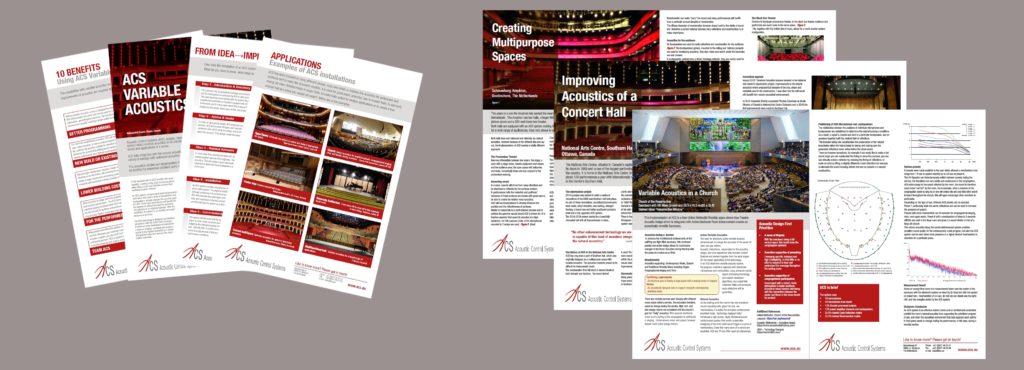ACS is well know for their natural sound.
Systems are installed to make acoustics variable such that halls can be used for multiple types of performances and to optimise/repair the natural acoustics.
The video below contains an introduction to ACS Variable acoustics
Brochures & News

A selection of brochures can be found on the ACS-downloads page, including a number of case studies on ACS-installations installed in different types of halls, check our News section if you would like to know the latest.
ACS: A BRIEF DESCRIPTION
What is acoustics?
In a room of a certain shape and size sound will be reflected off (or absorbed by) the materials/surfaces present, as for example the walls, ceilings, floor, seats, etc.
The way sound reflected (and re-reflected) by a sound source at a certain position as well as how the sum of direct and reflected sound is perceived by a listener at a particular position is what we call acoustics.
How does ACS change acoustics?
Acoustics are changed by adding sound reflections to those that are already present. To make sure this is done in a way that the listeners will perceive the total sum as being natural acoustics, it is of major importance that this happens at the correct place with the correct signals and timing.
A number of microphones. (typically 8-40) are used to pick up sound. The recorded sound is processed, amplified and reproduced using a number of strategically placed loudspeakers. (often mounted invisibly)
All loudspeakers together build a field of sound reflections which will change the acoustics.
How does this work in practice?
Generally a number of acoustics presets are programmed and together with the original acoustics of a particular venue this will enable the user to select, the acoustics best suited for particular type of performance.
So with a simple push of a button on a remote control. ACS can change the relatively dry acoustics of for example the typical modern Theater (suited for speech) into acoustics suited for chamber music or the lively acoustics of a good concert hall etc.
In Churches ACS systems are applied to change the acoustics during a service between dry acoustics for speech to acoustics with longer reverberation times for organ, choir and congregational singing.
But also in Concert halls ACS is used to repair acoustical flaws. For example to improve the frequency response and clarity /”presence” of sound and also reverberation times can be extended for particular types of performances.
Please check our many references.
ACS also provides special solutions, for example the Orchestra Shell Extension improving ensemble playing conditions for musicians on stage and Voicelift eliminating the need for dedicated microphones for speech reinforcement.
The ACS signal processing
ACS current AE-x series processing main-frame was developed in co-operation with the Delft technical university. The main-fame containing very powerful digital processing can hold up to 96 audio inputs as well as 96 individually processed audio outputs. Several AE frames can be connected together to form larger systems.
Because different venues require different solutions, 4 software processing modules were developed. One, or a combination of these modules are integrated in the main processing system and together they will form the system for variable acoustics.
System integration
ACS loudspeakers are generally integrated at many locations in the interior of a hall. Microphones record sound at a high quality from positions near the performers on stage. It is not uncommon that functionality can be shared, as for example combined use of amplifiers and loudspeakers for ACS and immersive sound/surround sound systems or use of ACS microphone signals for recordings or audio distribution systems.

